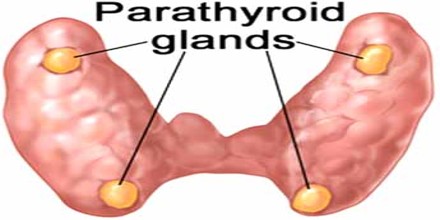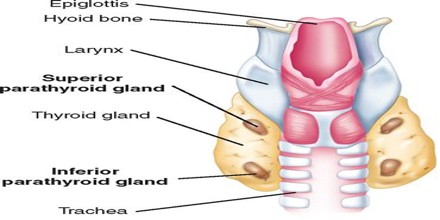Parathyroid Gland
Definition
Parathyroid Gland is a gland that regulates calcium, located behind the thyroid gland in the neck. The parathyroid gland secretes a hormone called parathormone (or parathyrin) that is critical to calcium and phosphorus metabolism. Parathyroid glands also control the calcium in our bodies–how much calcium is in our bones, and how much calcium is in our blood. Calcium is the most important element in our bodies; we use it to control many systems, so calcium is regulated very carefully. Parathyroid glands control the calcium. Humans usually have four parathyroid glands, each composed of closely packed epithelial cells separated by thin fibrous bands and some fat cells. The parathyroid glands secrete parathormone, also called parathyroid hormone (PTH), which functions to maintain normal serum calcium and phosphate concentrations.

Parathyroid Glands are derived from the epithelial lining of the third and fourth branchial pouches, with the superior glands arising from the fourth pouch, and the inferior glands arising from the higher third pouch. The relative position of the inferior and superior glands, which are named according to their final location, changes because of the migration of embryological tissues.
The only purpose of the parathyroid glands is to regulate the calcium level in our bodies within a very narrow range so that the nervous and muscular systems can function properly. This is all they do. They measure the amount of calcium in the blood every minute of every day and if the calcium levels go down a little bit, the parathyroid glands recognize it and make parathyroid hormone (PTH) which goes to the bones and takes some calcium out makes a withdrawal from the calcium vault and puts it into the blood. When the calcium in the blood is high enough, then the parathyroids shut down and stop making PTH.
Parathyroid Glands are found in all adult tetrapods; they vary in their number and position. Mammals typically have four parathyroid glands, while other types of animals typically have six. The removal of parathyroid glands in animals produces a condition resembling acute poisoning with irregular muscle contractions.
Fish do not possess parathyroid glands; several species have been found to express parathyroid hormone. Developmental genes and calcium-sensing receptors in fish gills are similar to those within the parathyroid glands of birds and mammals. It has been suggested that the tetrapod glands may have been evolutionarily derived from these fish gills.

Structure of Parathyroid Gland
Parathyroid Glands consist of four separate glands located on the posterior surface of the lobes of the thyroid gland. The cells of parathyroid glands are arranged in a compact mass and are of two types: small chief cells or principal cells and large oxyphil cells or eosinophil cells. The cells are enclosed by a delicate connective tissue capsule. The chief cells are much more numerous than the oxyphil cells. The latter are absent in the young and appear a little before the age of puberty.
Healthy parathyroid glands generally weigh about 30 mg in men and 35 mg in women. These glands are not visible or able to be felt during examination of the neck. The blood supply, drainage, and lymphatic drainage of the parathyroid glands correspond to the thyroid overlying gland. The superior parathyroid glands receive their blood from the inferior thyroid arteries. The inferior parathyroid glands receive a variable blood supply, from either the ascending branch of the inferior thyroid arteries or the thyroid ima artery. The inferior thyroid artery arises from the subclavian arteries.
Each parathyroid vein drains into the superior, middle and inferior thyroid veins. The superior and middle thyroid veins drain into the internal jugular vein, and the inferior thyroid vein drains into the brachiocephalic vein.
Parathyroid Glands are variable in number: three or more small glands, and can usually be located on the posterior surface of the thyroid gland. Occasionally, some individuals may have six, eight, or even more parathyroid glands. Rarely, the parathyroid glands may be within the thyroid gland itself, the chest, or even the thymus.
Parathyroid development is regulated by a number of genes, including those coding for several transcription factors.

Functions of Parathyroid Gland
The major function of the parathyroid glands is to maintain the body’s calcium and phosphate levels within a very narrow range, so that the nervous and muscular systems can function properly. The parathyroid glands do this by secreting parathyroid hormone (PTH).
Parathyroid hormone “regulates the metabolism of calcium.” Calcium is not only a major component of bones, but is also indispensable for blood clotting and for the contraction of every muscle in the body, including the heart. It is also an essential mineral for the proper functioning of brain cells.
Calcium is stored in the bones. Its release from the bones into the blood, as well as its absorption in the kidneys or intestines, is regulated by parathyroid hormone along with vitamin D. Thus, parathyroid hormone and vitamin D have the function of increasing calcium levels in the blood. Calcium levels, in turn, can affect the secretion of parathyroid hormone. Low levels of calcium in the blood induce the secretion of parathyroid hormone, resulting in increased calcium levels. On the other hand, high levels of calcium in the blood inhibit the secretion of parathyroid hormone, leading to decreased calcium levels. In this manner, calcium levels in the blood are regulated.
















